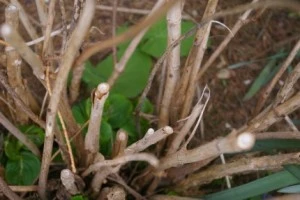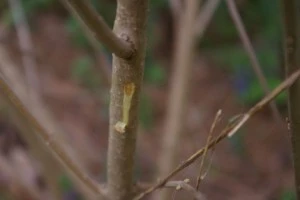 All day long, at the office and on the road in my clients gardens, I get the same question: are my hydrangeas DEAD??? Probably not is my answer. But most of the plants that bloom on current year’s wood lost a lot, if not all, of their old wood and are taking a long time to re-sprout. Examples include Rose of Sharon, butterfly shrubs, Caryopteris, and Hydrangea macrophylla and H. serrata species.
All day long, at the office and on the road in my clients gardens, I get the same question: are my hydrangeas DEAD??? Probably not is my answer. But most of the plants that bloom on current year’s wood lost a lot, if not all, of their old wood and are taking a long time to re-sprout. Examples include Rose of Sharon, butterfly shrubs, Caryopteris, and Hydrangea macrophylla and H. serrata species. Hydrangea 2The first thing you need to do is scratch the bark. If it is green below the bark, the wood is alive. If the branches are brittle and dried up and there is no green wood below the bark, the branch is not alive. Continue doing this until you find live wood. If it means you have to cut the plant back to ground level, do not worry. This category of plants will regenerate an entirely new top as soon as it gets a bit warmer. A couple of years ago I took this photo before I dragged my tarp filled with butterfly shrub and crape myrtle branches to the compost. They all died to the ground and guess what? They grew and bloomed just beautifully later that summer.Hydrangea 3
Hydrangea 2The first thing you need to do is scratch the bark. If it is green below the bark, the wood is alive. If the branches are brittle and dried up and there is no green wood below the bark, the branch is not alive. Continue doing this until you find live wood. If it means you have to cut the plant back to ground level, do not worry. This category of plants will regenerate an entirely new top as soon as it gets a bit warmer. A couple of years ago I took this photo before I dragged my tarp filled with butterfly shrub and crape myrtle branches to the compost. They all died to the ground and guess what? They grew and bloomed just beautifully later that summer.Hydrangea 3 Hydrangeas can be a complicated subject and I get tons of questions about how to prune them. Pink and blue hydrangeas (H. macrophylla and H. serrata) bloom on NEW SHOOTS off of LAST YEAR’S wood. It appears that a lot of last year’s wood did, in fact, die over the winter. Look for live buds as the weather warms up.Hydrangea 4 We generally refrain from pruning them until late May if we are not sure. On the right you can see the emerging buds on my Hydrangeas serrata. About half of the branches are showing life this week. If the old wood doesn’t sprout leaves, you won’t get any flowers UNLESS you have REBLOOMING hydrangeas such as ‘Endless Summer’ and her relatives that bloom on old AND new wood.
Hydrangeas can be a complicated subject and I get tons of questions about how to prune them. Pink and blue hydrangeas (H. macrophylla and H. serrata) bloom on NEW SHOOTS off of LAST YEAR’S wood. It appears that a lot of last year’s wood did, in fact, die over the winter. Look for live buds as the weather warms up.Hydrangea 4 We generally refrain from pruning them until late May if we are not sure. On the right you can see the emerging buds on my Hydrangeas serrata. About half of the branches are showing life this week. If the old wood doesn’t sprout leaves, you won’t get any flowers UNLESS you have REBLOOMING hydrangeas such as ‘Endless Summer’ and her relatives that bloom on old AND new wood.Our native Hydrangea arborescens ‘Annabelle’ is a completely different story. Her tops are hardy to zone 4 and I saw no dieback at all. Below are pictures of my ‘Annabelle’ before and after pruning last week.


Comments (0)
Sorry! The comments have been closed.